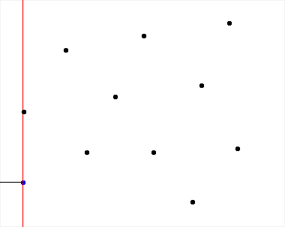|
Fortune's Algorithm
Fortune's algorithm is a sweep line algorithm for generating a Voronoi diagram from a set of points in a plane using O(''n'' log ''n'') time and O(''n'') space. Section 7.2: Computing the Voronoi Diagram: pp.151–160. It was originally published by Steven Fortune in 1986 in his paper "A sweepline algorithm for Voronoi diagrams." Algorithm description The algorithm maintains both a sweep line and a ''beach line'', which both move through the plane as the algorithm progresses. The sweep line is a straight line, which we may by convention assume to be vertical and moving left to right across the plane. At any time during the algorithm, the input points left of the sweep line will have been incorporated into the Voronoi diagram, while the points right of the sweep line will not have been considered yet. The beach line is not a straight line, but a complicated, piecewise curve to the left of the sweep line, composed of pieces of parabolas; it divides the portion of the ... [...More Info...] [...Related Items...] OR: [Wikipedia] [Google] [Baidu] |
Directrix (conic Section)
In mathematics, a conic section, quadratic curve or conic is a curve obtained as the intersection of the surface of a cone with a plane. The three types of conic section are the hyperbola, the parabola, and the ellipse; the circle is a special case of the ellipse, though historically it was sometimes called a fourth type. The ancient Greek mathematicians studied conic sections, culminating around 200 BC with Apollonius of Perga's systematic work on their properties. The conic sections in the Euclidean plane have various distinguishing properties, many of which can be used as alternative definitions. One such property defines a non-circular conic to be the set of those points whose distances to some particular point, called a ''focus'', and some particular line, called a ''directrix'', are in a fixed ratio, called the ''eccentricity''. The type of conic is determined by the value of the eccentricity. In analytic geometry, a conic may be defined as a plane algebraic curve of deg ... [...More Info...] [...Related Items...] OR: [Wikipedia] [Google] [Baidu] |
Power Diagram
In computational geometry, a power diagram, also called a Laguerre–Voronoi diagram, Dirichlet cell complex, radical Voronoi tesselation or a sectional Dirichlet tesselation, is a partition of the Euclidean plane into polygonal cells defined from a set of circles. The cell for a given circle ''C'' consists of all the points for which the power distance to ''C'' is smaller than the power distance to the other circles. The power diagram is a form of generalized Voronoi diagram, and coincides with the Voronoi diagram of the circle centers in the case that all the circles have equal radii.... Definition If ''C'' is a circle and ''P'' is a point outside ''C'', then the power of ''P'' with respect to ''C'' is the square of the length of a line segment from ''P'' to a point ''T'' of tangency with ''C''. Equivalently, if ''P'' has distance ''d'' from the center of the circle, and the circle has radius ''r'', then (by the Pythagorean theorem) the power is ''d''2 − ''r''2 ... [...More Info...] [...Related Items...] OR: [Wikipedia] [Google] [Baidu] |
Treemap
In information visualization and computing, treemapping is a method for displaying hierarchical data using nested figures, usually rectangles. Treemaps display hierarchical ( tree-structured) data as a set of nested rectangles. Each branch of the tree is given a rectangle, which is then tiled with smaller rectangles representing sub-branches. A leaf node's rectangle has an area proportional to a specified dimension of the data. Often the leaf nodes are colored to show a separate dimension of the data. When the color and size dimensions are correlated in some way with the tree structure, one can often easily see patterns that would be difficult to spot in other ways, such as whether a certain color is particularly relevant. A second advantage of treemaps is that, by construction, they make efficient use of space. As a result, they can legibly display thousands of items on the screen simultaneously. Tiling algorithms To create a treemap, one must define a tiling algorithm, tha ... [...More Info...] [...Related Items...] OR: [Wikipedia] [Google] [Baidu] |
Pseudocode
In computer science, pseudocode is a plain language description of the steps in an algorithm or another system. Pseudocode often uses structural conventions of a normal programming language, but is intended for human reading rather than machine reading. It typically omits details that are essential for machine understanding of the algorithm, such as variable declarations and language-specific code. The programming language is augmented with natural language description details, where convenient, or with compact mathematical notation. The purpose of using pseudocode is that it is easier for people to understand than conventional programming language code, and that it is an efficient and environment-independent description of the key principles of an algorithm. It is commonly used in textbooks and scientific publications to document algorithms and in planning of software and other algorithms. No broad standard for pseudocode syntax exists, as a program in pseudocode is not an executa ... [...More Info...] [...Related Items...] OR: [Wikipedia] [Google] [Baidu] |
Priority Queue
In computer science, a priority queue is an abstract data-type similar to a regular queue or stack data structure in which each element additionally has a ''priority'' associated with it. In a priority queue, an element with high priority is served before an element with low priority. In some implementations, if two elements have the same priority, they are served according to the order in which they were enqueued; in other implementations ordering of elements with the same priority remains undefined. While coders often implement priority queues with heaps, they are conceptually distinct from heaps. A priority queue is a concept like a list or a map; just as a list can be implemented with a linked list or with an array, a priority queue can be implemented with a heap or with a variety of other methods such as an unordered array. Operations A priority queue must at least support the following operations: * ''is_empty'': check whether the queue has no elements. * ''insert_wi ... [...More Info...] [...Related Items...] OR: [Wikipedia] [Google] [Baidu] |
Binary Search Tree
In computer science, a binary search tree (BST), also called an ordered or sorted binary tree, is a rooted binary tree data structure with the key of each internal node being greater than all the keys in the respective node's left subtree and less than the ones in its right subtree. The time complexity of operations on the binary search tree is directly proportional to the height of the tree. Binary search trees allow binary search for fast lookup, addition, and removal of data items. Since the nodes in a BST are laid out so that each comparison skips about half of the remaining tree, the lookup performance is proportional to that of binary logarithm. BSTs were devised in the 1960s for the problem of efficient storage of labeled data and are attributed to Conway Berners-Lee and David Wheeler. The performance of a binary search tree is dependent on the order of insertion of the nodes into the tree since arbitrary insertions may lead to degeneracy; several variations of the bi ... [...More Info...] [...Related Items...] OR: [Wikipedia] [Google] [Baidu] |
Parabola
In mathematics, a parabola is a plane curve which is mirror-symmetrical and is approximately U-shaped. It fits several superficially different mathematical descriptions, which can all be proved to define exactly the same curves. One description of a parabola involves a point (the focus) and a line (the directrix). The focus does not lie on the directrix. The parabola is the locus of points in that plane that are equidistant from both the directrix and the focus. Another description of a parabola is as a conic section, created from the intersection of a right circular conical surface and a plane parallel to another plane that is tangential to the conical surface. The line perpendicular to the directrix and passing through the focus (that is, the line that splits the parabola through the middle) is called the "axis of symmetry". The point where the parabola intersects its axis of symmetry is called the "vertex" and is the point where the parabola is most sharply curved. The ... [...More Info...] [...Related Items...] OR: [Wikipedia] [Google] [Baidu] |
Sweep Line Algorithm
In computational geometry, a sweep line algorithm or plane sweep algorithm is an algorithmic paradigm that uses a conceptual ''sweep line'' or ''sweep surface'' to solve various problems in Euclidean space. It is one of the key techniques in computational geometry. The idea behind algorithms of this type is to imagine that a line (often a vertical line) is swept or moved across the plane, stopping at some points. Geometric operations are restricted to geometric objects that either intersect or are in the immediate vicinity of the sweep line whenever it stops, and the complete solution is available once the line has passed over all objects. History This approach may be traced to scanline algorithms of rendering in computer graphics, followed by exploiting this approach in early algorithms of integrated circuit layout design, in which a geometric description of an IC was processed in parallel strips, because the entire description could not fit into memory. Applications Application ... [...More Info...] [...Related Items...] OR: [Wikipedia] [Google] [Baidu] |
Piecewise
In mathematics, a piecewise-defined function (also called a piecewise function, a hybrid function, or definition by cases) is a function defined by multiple sub-functions, where each sub-function applies to a different interval in the domain. Piecewise definition is actually a way of expressing the function, rather than a characteristic of the function itself. A distinct, but related notion is that of a property holding piecewise for a function, used when the domain can be divided into intervals on which the property holds. Unlike for the notion above, this is actually a property of the function itself. A piecewise linear function (which happens to be also continuous) is depicted as an example. Notation and interpretation Piecewise functions can be defined using the common functional notation, where the body of the function is an array of functions and associated subdomains. These subdomains together must cover the whole domain; often it is also required that they are pair ... [...More Info...] [...Related Items...] OR: [Wikipedia] [Google] [Baidu] |
Sweep Line
In computational geometry, a sweep line algorithm or plane sweep algorithm is an algorithmic paradigm that uses a conceptual ''sweep line'' or ''sweep surface'' to solve various problems in Euclidean space. It is one of the key techniques in computational geometry. The idea behind algorithms of this type is to imagine that a line (often a vertical line) is swept or moved across the plane, stopping at some points. Geometric operations are restricted to geometric objects that either intersect or are in the immediate vicinity of the sweep line whenever it stops, and the complete solution is available once the line has passed over all objects. History This approach may be traced to scanline algorithms of rendering in computer graphics, followed by exploiting this approach in early algorithms of integrated circuit layout design, in which a geometric description of an IC was processed in parallel strips, because the entire description could not fit into memory. Applications Application ... [...More Info...] [...Related Items...] OR: [Wikipedia] [Google] [Baidu] |



